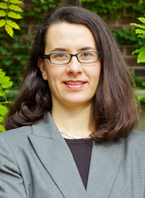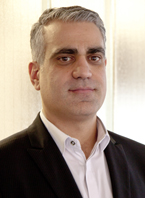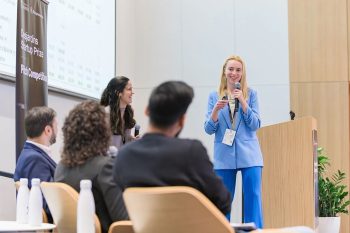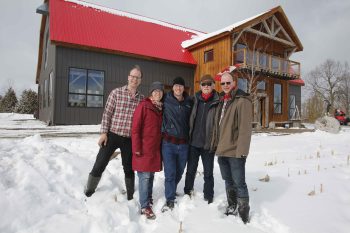Three U of T engineers – Professors Constantin Christopoulos (CivE), Joyce Poon (ECE) and Milica Radisic (IBBME, ChemE) – have received new Canada Research Chairs (CRC), while a fourth chair held by Professor Warren Chan (IBBME) was renewed. The chairs will support research in earthquake engineering, cardiac tissue engineering, and energy use in large data centres, along with continued work in the use of nanotechnology in the diagnosis and treatment of cancer.
“We take pride in the accomplishments of our tremendous researchers in the Faculty of Applied Science & Engineering and are pleased that four of our colleagues are recognized today by the Canada Research Chair program,” said Engineering Dean Cristina Amon. “I am glad the outstanding work of Professors Christopoulos, Poon and Radisic have attracted this prestigious support, while I also congratulate Professor Chan on the significant scholarship that has led to the renewal of his Chair.”

For Professor Radisic, being named the CRC in Functional Cardiovascular Tissue Engineering will enable her research on the generation of heart muscle tissue, or myocardium. When a heart attack occurs, heart tissue dies and is replaced by scar tissue. The result is a heart that never beats the same again. Professor Radisic’s work is focused on the regeneration of the myocardium to restore the heart’s normal rhythm.
“I was really happy because this will mean that my time will be protected … so that I can focus on my research,” said Professor Radisic, who noted the recognition was also welcome. “The panel looked at my proposal and felt it was worthy of a Canada Research Chair. So that sort of recognition feels good.”
Professor Radisic will use the time and support afforded by her new CRC to develop biomaterials, such as a cardiac patch to aid treatment, as well as new methods for cell separation to isolate cardiomyocytes, which are the cells that comprise heart muscle, to aid further research in the field.

Professor Christopoulos hopes to use his new CRC in Seismic Resilience of Infrastructure to rethink Canada’s building codes as they apply to earthquakes.
“The current goal (of the code) is to maintain life and avoid a complete building collapse … In theory, if the last person exiting the building were to close the door and cause the entire building to collapse behind them, then that building would have met the life-safety goal of our national building code,” explained Professor Christopoulos.
He pointed to the example of Christchurch, New Zealand, where a series of earthquakes have left the city decimated, with the most significant quake occurring on February 22, 2011.
“Following that earthquake, in the downtown core of Christchurch, out of 2,500 buildings it is forecast that less than 10% will not have to be demolished,” stated Professor Christopoulos. “If I look at the impact on Christchurch, the codes did their job, and we have a city falling apart because economically the city is devastated,” he added.
Human safety in the event of a seismic event should always be the first and most important consideration, Professor Christopoulos noted. However, he asserted that more must be done to limit building damage in order to mitigate the long-term economic impact earthquakes can cause.
He is working to develop new technologies that can allow a building to soften during an earthquake, but that will allow it to spring back into its original position, leaving it almost undamaged after an earthquake.

Professor Poon is also tackling a large-scale problem, but one that often goes unseen. Currently, a huge amount of energy is required to enable cloud computing, in which large files are stored on remote computer servers and remotely accessed through the Internet. Those remote data centres collectively consume 220 billion kilowatt hours annually – a number that is growing by 10–15% each year. That, said Professor Poon, is unsustainable.
“In order to solve this problem, people are starting to look at optical communications for these shorter communication lengths within these really large computer facilities,” she said.
Transmitting information with light, over fibre-optic strands for example, can take up substantially less energy and carry more data at faster rates than traditional wires. Currently, it can take more power to send a signal electrically over traditional wires than it takes for the computer to process it.
“These data centres are like the really old way of computing, with very large bulky machines that take up huge rooms. Eventually, these data centres and super computers could shrink to a chip… then they can be much more efficient than they are today,” said Professor Poon.

When Professor Chan (IBBME) learned his CRC in Biotechnology was being renewed for a second, five-year term, he saw it as an indication of support for the work done during his first term.
His focus was on the development of nanoparticles to identify and image cancerous tumors. Developing an accurate picture of the tumor is critical to ensuring an accurate diagnosis and treatment. The nanoparticles’ properties help to develop a clear image that can be a powerful tool in the fight against cancer. The challenge is that the nanoparticles which help to create the image can be expelled from the body before ever reaching the disease site. In fact, only 5% of the particles reach their intended destination.
“The field (of research) has always changed every five years,” explained Professor Chan. “If you want to move up to the next level, you have to identify what that next stage is going to be.”
For Professor Chan, his focus for the next five years will be on the targeted delivery of the nanoparticles and to develop more sophisticated tagging techniques that will help doctors better understand the molecular structure of the cancer cells involved.
While Professors Christopoulos, Radisic and Poon look forward to the benefits of the CRC program, Professor Chan explained the prestige of the recognition can be the greatest reward.
“When you write a grant, it helps. Having a CRC says that you are a leader in that particular field,” said Professor Chan.
The CRC program was established in 2000 by the federal government to support outstanding research at universities across Canada. The four chairs represent $100,000 a year for five years each, which will provide a combined $2-million in new funding for these areas of research.
Professor Paul Young, U of T’s vice-president (research) offered his congratulations to the new and renewed CRC holders. “We at the University of Toronto are proud that so many of our faculty members have been awarded CRCs. This is a testament to the scholarly excellence and consistent leadership shown by our researchers. I extend my thanks, on behalf of U of T, to the government of Canada for its continued support of our researchers – and of research across the country – through the CRC program.”



